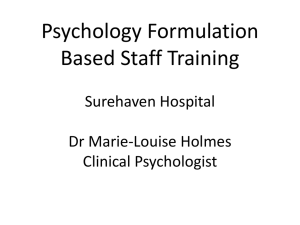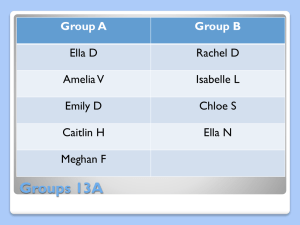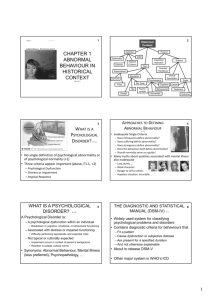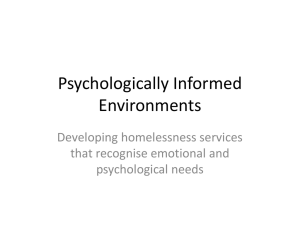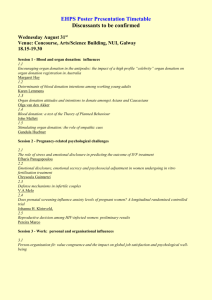Understand psychological approaches to health and
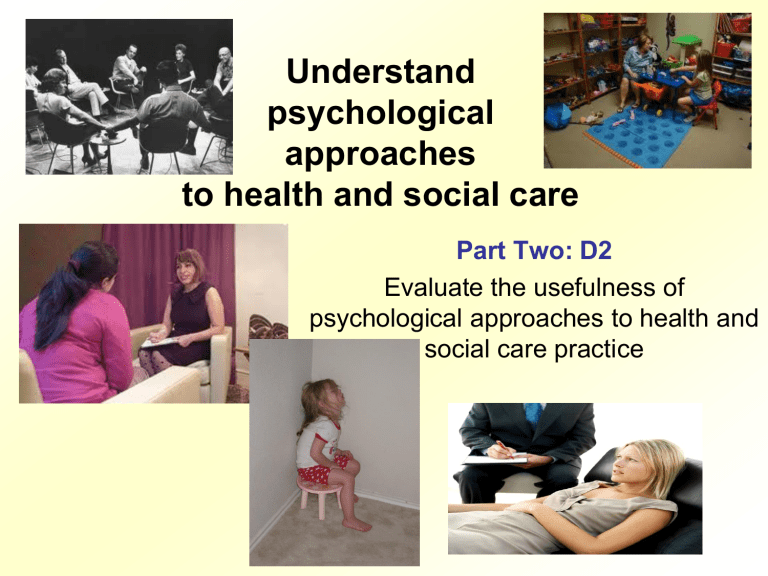
Understand psychological approaches to health and social care
Part Two: D2
Evaluate the usefulness of psychological approaches to health and social care practice
Understand psychological approaches to health and social care
Learning Outcome
- The learner will:
Assessment
Criteria Pass -
The learner can:
Merit – in addition to the pass criteria the learner can:
Distinction –
In addition to the pass and merit criteria the learner can:
Understand psychological approaches to health and social care
P2
Explain different psychological approaches to health practice
P3
Explain different psychological approaches to social care practice
M1
Explain how practitioners could apply psychological approaches to health and social care practice
D2
Evaluate the usefulness of psychological approaches to health and social care practice
•
There are many theories in psychology but some work better in certain areas than others. Psychodynamic works best with people who have good communication skills.
Most care workers will be able to use a problem solving framework to help them decide which approach to use. However, some care workers will specialise in certain approaches. Factors which help them decide include:
What has worked well in the past
Approaches which give quick results
What training has been given
Age, culture and understanding of the client.
assessment
Working hypothesis intervention review
How do you chose an approach?
Evaluating approaches – looking at strengths and weaknesses.
• A care practitioner may choose from the theories to help their client.
• It would depend on the nature of the client’s concerns, the training and experience of the practitioner and how comfortable the care worker felt with using a particular model.
• To evaluate an approach, the strengths and weaknesses need to be considered as well as the impact it would have on a service user.
•The Behavioural approach looks at observed behaviour
•The Cognitive approach listens to the client
•The Humanistic approach listens to the client and gives the client choices
•The Psychodynamic approach interprets what the person says and does
In pairs think about the strengths and weaknesses of each approach
Think of ONE health or social care example where the approach would work
•
Theory is easy to understand
• Experimental work to show how behaviour reinforcement works
• It’s objective and people can agree on what is happening- only observable behaviour is looked at
•
Easy to put into practice
– people do this approach “naturally”
• Results can be quick and it is shown to work
• Doesn’t rely on communication skills so can work with all ages and abilities
•
Also easy to use on anxious service users
• Can “shape behaviour” gradually and a person can develop “new” behaviours and skills.
• Doesn’t label people as “abnormal” and so avoids labelling people
Behavioural approach
• Doesn’t look at what is going on inside someone’s head – makes it narrow and limited
• People can’t work on helping themselves as there is no thinking involved
• Deals with symptoms not causes so can be short term
•
Behaviours caused by anxiety etc can be exhibited in other ways and behaviours – symptom substitution
•
Time out and other methods of behaviour modification can be seen as upsetting and demeaning – how is it different from punishment
•
Manipulative and dehumanising
– sees humans as people who simply respond and repeat actions which give them pleasure
•
Deterministic
– doesn’t allow humans choice
• Does it follow the care base values?
Psychodynamic
Approach
• Gets to the root of problems
• Effective as it gives the client an insight into why they think or feel as they do
• Can change many parts of their lives, not just behaviour
• Respectful
• Been used for a long time and has been seen to work effectively
• Can be used for a wide range of problems including sexual disorders, depression and eating problems.
•
Tries to work out why irrational beliefs arise which leads to many problems being looked at all at the same time
•
Theories very complicated to understand
• Practitioners need specialist training which may take a long time – they view themselves as the “expert” and only they can sort out the problems
• Client can get over reliant on therapist
•
Theory is not based on science but how the psychotherapist interprets what the client says
•
Based on unconscious thoughts and analysation of what people think and do
• Harmful as the insights can be very distressing for the client
•
False memory syndrome is controversial
• Deterministic view of life – we have little control of our actions because of what has happened in our early childhood
• Lengthy and costly
• Some claim it doesn’t actually work and it is hard to assess or measure it’s success as an approach
• Theory is based on Freud who worked with middle class patients in Vienna at the end of the last century - how relevant are his interpretations to modern life?
Cognitive approach
• Structured approach of understanding and changing behaviour
• Theory is easy to understand and process of theory is understood – it makes sense to the client.
• Pays attention to what the client says – what the person thinks and feels
• Therapist then looks for faulty or dysfunctional beliefs which affects how the client behaves.
• There is no therapist interpretation or finding
“hidden meanings”
• Direct approach
• Easy to learn and apply – clients can learn the techniques and use themselves in other areas of their lives
• Aims for independence of the client – empowerment is key and so follows the care value base
• Widely used in health care and can be applied to a wide range of issues e.g. stress, anxiety, anger management
• Cost effective and can be relatively quick
• Not suitable for all as it relies on good language skills – the client needs to be able to express their thoughts and understand what the counsellor wants them to do
• Hard to use with those that can’t follow a rational train of thought
• Doesn’t deal with the underlying causes of problems
• One problem worked on at a time
• Debate on it’s effectiveness – some studies show it works, some show it doesn’t
Humanistic Approach
•
Person centred
• Therapist is non intrusive – meet clients as equals in the process and not as the expert
• Training is not dependant on other professional qualifications
• Doesn’t label client
• Follows the care value base
•
Unconditional regard, empathy and genuineness are qualities many health care workers have already
• Centres around the thought that people have choices and can change their lives
– to become much more than they are
(self actualisation)
• Can be applied to many situations
•
Very positive view!
• Focuses on the short term nature of therapy
• Ignores innate problems that could be causing behaviours
• Short term
• Client needs good communication skills
• Difficult to show effectiveness
• No uniformity in training
• Key terms difficult to understand e.g. congruence, self actualisation
• Therapist has be non judgemental to all people which can be hard to obtain
AM I trained and competent
In this approach?
Is it cost effective?
Will it work?
Has it worked in the past?
Does it seem to fit the with the presenting
Problem?
Can I do an assessment?
What interventions can I use?
What approach will I use with this service user?
Does it fit with our
Care value base?
What are the risks?
Are these risks acceptable?
What questions should a care worker ask before using an approach?
Task D2
Evaluate the usefulness of psychological approaches to health and social care practice
You will need to consider our discussions on evaluating the approaches, and read the case studies provided before doing this task. If you use primary evidence remember confidentiality
For the final part of your training you need to show that you can evaluate the usefulness of the psychological approaches used in HSC.
Prepare materials that show you have considered the usefulness of the approach, the impact the approach may have on a service user and the situations in HSC where the approaches may be used. You MUST show that you have considered the strengths and weaknesses of the four major approaches used.








